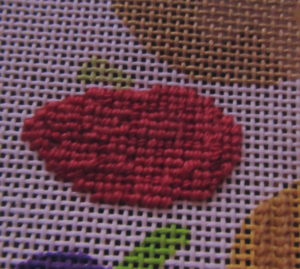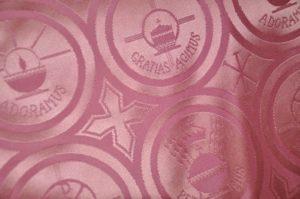
Today we start the stitch-along with the coral pumpkin. Mine was stitched using two kinds of silk: Trebizond and Pepprepot. The canvas is from Blue Dogwood Designs. Use threads in contrasting textures from your stash for each pumpkin.
It’s stitched in Triplets, below, a needlepoint damask pattern. The next section explains needlepoint damask. I used Trebezond for the horizontal and vertical bars.

Stitch the pumpkin in Tent following the diagram above using two coral threads in contrasting textures. You can assign the threads as you like, but the texture contrast needs to be strong or enhanced by color changes. With damasks the key to succes is contrast. If the textures are too similar, the attern will not show up.
What Is Needlepoint Damask?
Damask is the name for a richly patterned fabric where the pattern is woven into the fabric, usually by threads in the same color but a different texture from the other threads in the fabric. These days I encounter them most often in our priest’s vestments at Mass. There are almost always made of damask in the proper liturgical color (rose today!). Liturgical vestments have been made of damask in the Catholic and Orthodox Churches for centuries. An example is pictured below.

You will also find dmask used for curtains and upholstery in more formal rooms although this is somewhat old-fashioned. In formal table cloths and napkins you’ll often find damask in white or cream. I have an usual set in lavender that was my mother-in-law’s from back in the 1950’s.
Heavier fabrics of a similar patterned weave where two colors instead of two textures are used are called brocades.
As a fabric damask is unusual because it is double-faced. This means that there are two threads going across each row. This makes the pattern on the back the opposite of the pattern on the front. For example, if the front had shiny wide stripes and narrow matte stripes, the back would have wide matte stripes and narrow shiny ones.
Many years ago I got the idea to enliven the background of a mini-sock by creating a pattern of matte wool diamonds and shiny pearl cotton diamonds. It turned out beautifully. I set aside the idea for awhile until I came across a book of Tent Stitch patterns from the 1970’s. These were lovely geometric patterns, but were always stitched in bright clashing colors as backgrounds. They always were so loud they drowned out the focal point.
I decided to combine the two ideas and was delighted by the result. Since then I have been enchanted by this easy technique and use it often.
Come back next week for the yellow-orange pumpkin.
About Janet M Perry
Janet Perry is the Internet's leading authority on needlepoint. She designs, teaches and writes, getting raves from her fans for her innovative techniques, extensive knowledge and generous teaching style. A leading writer of stitch guides, she blogs here and lives on an island in the northeast corner of the SF Bay with her family

Hi Janet, can you clarify? You say “ . I used Trebezond for the horizontal and vertical bars.”. Where did you use the Pepperpot? Do you use one for vertical and the other for horizontal, or randomly use both for horizontal and vertical? It’s hard to tell from the photo. Thanks!
Trebizond is used for all the stitches that are shown in the diagram. Pepperpot is used for all the other stit cheese. In most of these patterns only the stitches for one thread are shown. The remainder are made with the other thread. This makes the diagrams easier to read.
Keep stitching,
Janet
Thanks! Now I see it!
What count canvas are you using? If 13, what would be your recommendation for 18 ct. Love this stitch combo. Thanks
The canvas is from Blue Dogwood and is on 18.
Keep stitching,
Janet
Janet
Again, I am not receiving your e-mails. I found this by accident included in a ChillyHallow email. I dud receive the pumpkin canvas. Could you please add me to the email.
There is no mailing list for this project. It is completely done here on the Nuts about Needlepoint blog on Sundays. You can, however, sybscribe to the blog by using the subscriptioon barto the right.
Keep stitching,
Janet